I. Introduction
Following the novel coronavirus disease (COVID-19) out-break in Wuhan, China, in December 2019, COVID-19 had spread rapidly to other countries, including Korea and Japan, two of the closest countries to China. Korea and Japan’s first confirmed case was reported on January 19, 2020 and January 16, 2020, respectively. Considering its severity, the World Health Organization declared this disease as a pandemic on March 11, 2020 [
1].
By April 30, 2020, the incidence rate of COVID-19 in Korea (10,765 confirmed cases, 247 deaths) and Japan (14,119 confirmed cases, 435 deaths) showed downward trends, due to the responses of both governments [
2]. However, the physical and psychological stress among the general public has continued, given the continued occurrence of new confirmed cases. Psychological counseling services have reportedly increased after the emergence of COVID-19 due to the increased incidence of depression and excessive stress [
3–
5]. Previous studies also indicated the possibility of increased distress and psychological fatigue among the general public due to the escalation of governmental regulations [
6].
In response, the Korean government announced “psychological quarantine” on March 6 for the psychological stress induced by COVID-19. Their National Trauma Center (
http://nct.go.kr) provides “COVID-19 Integrated Psychological Support Group”, “Ways to keep good mental health”, and “Counseling services to patients and their parents” [
7]. The Japanese Ministry of Health, Labor, and Welfare has implemented psychological treatment & support projects in response to COVID-19. They provide counseling in the form of a chat called “Consultation of the social network services (SNS) mind related to COVID-19” [
8]. While these national-level mental health/stress policies should be implemented after properly identifying citizens’ mental health conditions, stress, and needs concerning COVID-19, previous studies showed that the COVID-19 mental health policies in Korea and Japan lacked information about these needs [
9,
10]. People from different countries show different reactions to the COVID-19 pandemic due to their different sensitivities, government responses, and psychological support; thus, consideration of these diverse aspects is critical [
11–
13].
In recent years, Internet and smartphone usage has increased rapidly, and social media platforms function as new modern forms of communication. More than 60% of Koreans use the Internet for social networking, and more than 50% of Japanese reported using more than one SNS platform. As a major social media platform, previous studies analyzed the perceptions and emotional status of the public through Twitter, which showed that social media platforms could reflect users’ emotional states [
14].
This study analyzed the perceptions and emotions of Korean and Japanese citizens regarding COVID-19. It analyzed the frequency of words used in Korean and Japanese tweets related to COVID-19 and the corresponding changes in their interests. It also aimed to provide evidence to establish the COVID-19 mental health policies of both governments.
Go to :

IV. Discussion
This study analyzed the perceptions and emotions of Korean and Japanese citizens about COVID-19 to gain insight for future COVID-19 responses.
There was a difference in the number of tweets between Korea and Japan. The final analysis included 1,470,313 tweets from Korea and 4,195,457 tweets from Japan; the daily Japanese tweets were limited because of their volume. Most Japanese citizens mainly use Twitter as SNS [
16] rather than Facebook or Instagram, whereas the ranking of Twitter usage rate by Koreans is 7th (0.2%), which is relatively lower than Japan [
17]. This may be due to the difference in populations: the current population of Japan (126,264,931) is 2.4 times higher than Korea (51,709,098) [
18].
Based on the heat diagram analysis of the tweets, the words “Online”, “Economy”, and “Donation” had gradually reached a high rank since April 2020. Beginning March 1, elementary, middle, and high schools were temporarily closed and moved to online classes, which possibly affected the high ranks of “Online”. The frequency of the word “Online” continuously increased after the Korean Ministry of Education announced an online education system on March 31 [
19]. Citizens showed an interest in the economy, which is one of the major effects of COVID-19 in Korea. The economic growth rate (−0.1%) had declined after COVID-19 compared to 2019 (2.0%). This also affected Koreans’ perceptions of the economy, reporting it as the most difficult economic time since the International Monetary Fund (IMF) intervention in 1998 [
20].
The words “Travel” and “Postpone” were ranked high at the beginning of February 2020, but their ranks gradually decreased. “Travel” began to be rarely mentioned in tweets and disappeared from the rank list after February 25, indicating that Koreans had changed their opinions regarding traveling. The rapid spread of COVID-19 from the last week of February might have affected people’s interest in traveling. The number of flights and travelers had sharply declined to 70.8%, which provided an additional explanation for this trend [
21]. Regarding “Postpone,” school reopening and events were postponed for 1 to 2 months in the early stages of COVID-19; however, due to their continuous delay [
19], people may have begun to lose interest in it.
In Japan, “COVID-19 (Corona)”, “Impact (影響)”, “Mask (マスク)”, “China (中国)”, “Response (対応)”, “Economy (経済)”, and “Government (政府)” were highly ranked between February 5 and April 30. The Japanese government distributed two face masks per household on April 17, which generated significant public opinion and possibly affected the high rank of the word “Mask”. Similar to Korea, Japanese citizens showed interest in their economy, reflecting their difficult economic situation compared to 2019. The cancellation of the Olympics by Japan, the host country, may explain the continued increase in the rank of “Olympics”. The rank of “Washing hands” decreased in March and then again increased since April, indicating people’s interest in personal non-pharmaceutical interventions (NPIs). The Japanese government emphasized isolation and strict social distancing until March, and then promoted personal NPIs since April [
22].
We divided the words into four categories, namely, social distancing, prevention, issue, and emotion, to analyze the rank flowcharts. Regarding social distancing, the word “World” began to increase in Korea since March 4, 2020, which is close to the time of a pandemic declaration by the World Health Organization (WHO). In Japan, contrary to the decreasing number of indicators related to going outside (traffic volume, using of public transportation, etc.), the word “going out” had continuously increased since February 19th. Considering the request to stay home and close schools, the rank for the word “Postpone” continued to decrease and “Home” began to increase.
Regarding prevention, the high rank of “Mask” in both countries can be explained by the high compliance of wearing masks in Korea and Japan (Korea 78.7%; Japan 77.0%) [
23]. In April, the words related to personal prevention began to rank higher compared to March, which showed a decline in ranks, thereby indicating citizens’ increased interest in personal NPIs. This trend may be based on changes in policies of both governments, which shifted focus to personal hygiene from strict social distancing.
In Korea, after the government announced the disaster relief plan and people began donating for COVID-19 eradication, the rank of “Economic” and “Donation” increased on March 25. In contrast, the rank of “Olympics” in Japan decreased from March 25, the day Japan postponed the Olympics scheduled for 2020. The word “Store” emerged in the rank list from March 4. Some infected cases emerged in several stores during the first week of March, and Japanese local governments began to request stores to close temporarily from April, which may have affected this trend [
24].
Concerning emotion, the rank of “Please” consistently increased in Korea. A previous study showed that people with high compliance of personal prevention experienced high psychological stress due to those who did not maintain the preventive practices [
25], which might have affected the increasing numbers of tweets with requests to maintain preventive measures. Furthermore, the word “Please” was also associated with the wish to end the COVID-19 pandemic. We also observed the increasing ranks of “Overcome” and “Support”, which reflected the current economic slump. In Japan, the citizens expected the COVID-19 pandemic to end since they mentioned the word “End” frequently. In contrast, the mention of the words “Worry (心配)” and “Anxiety (不安)” decreased from April, which showed Japanese adaptations and insensibilities toward COVID-19. The WHO issued warnings about the possibility of a second pandemic after several countries eased their policies and citizens began to relax regarding COVID-19 [
26].
This study has some limitations. First, it did not represent all age groups because the SNS was mainly used by the younger generation compared to the elderly generation. Second, although there are several SNS platforms such as Facebook, Never, Yahoo, Twitter, Instagram, KakaoTalk, and Band, we only collected posts from Twitter because of the API permission.
To minimize non-sampling error, we limited data collection to twitter although Naver in Korea and Yahoo in Japan are the most popular website. Future studies should analyze posts from various SNS to sufficiently represent the public opinion of each country.
In conclusion, this study analyzed the perceptions and emotions of Korean and Japanese citizens about COVID-19 to gain insight for future COVID-19 responses. The words in high frequencies were COVID-19, Shincheonji, Mask, Daegu and Travel in Korea, and COVID-19, Mask, Inspection, Capability and China in Japan. In both countries, COVID-19 and masks were frequently searched. As result of the rank flowchart, we observed that peoples’ interests in the economy were high in both countries, which showed their worries about the economic downturn as a result of COVID-19 on twitter. Although interest in prevention increased since April in both countries, it also showed that the general public began to assuage their worries regarding COVID-19. We strongly suggest that psychological support strategies should be established in consideration of their various aspects of emotions.
Go to :





 PDF
PDF Citation
Citation Print
Print



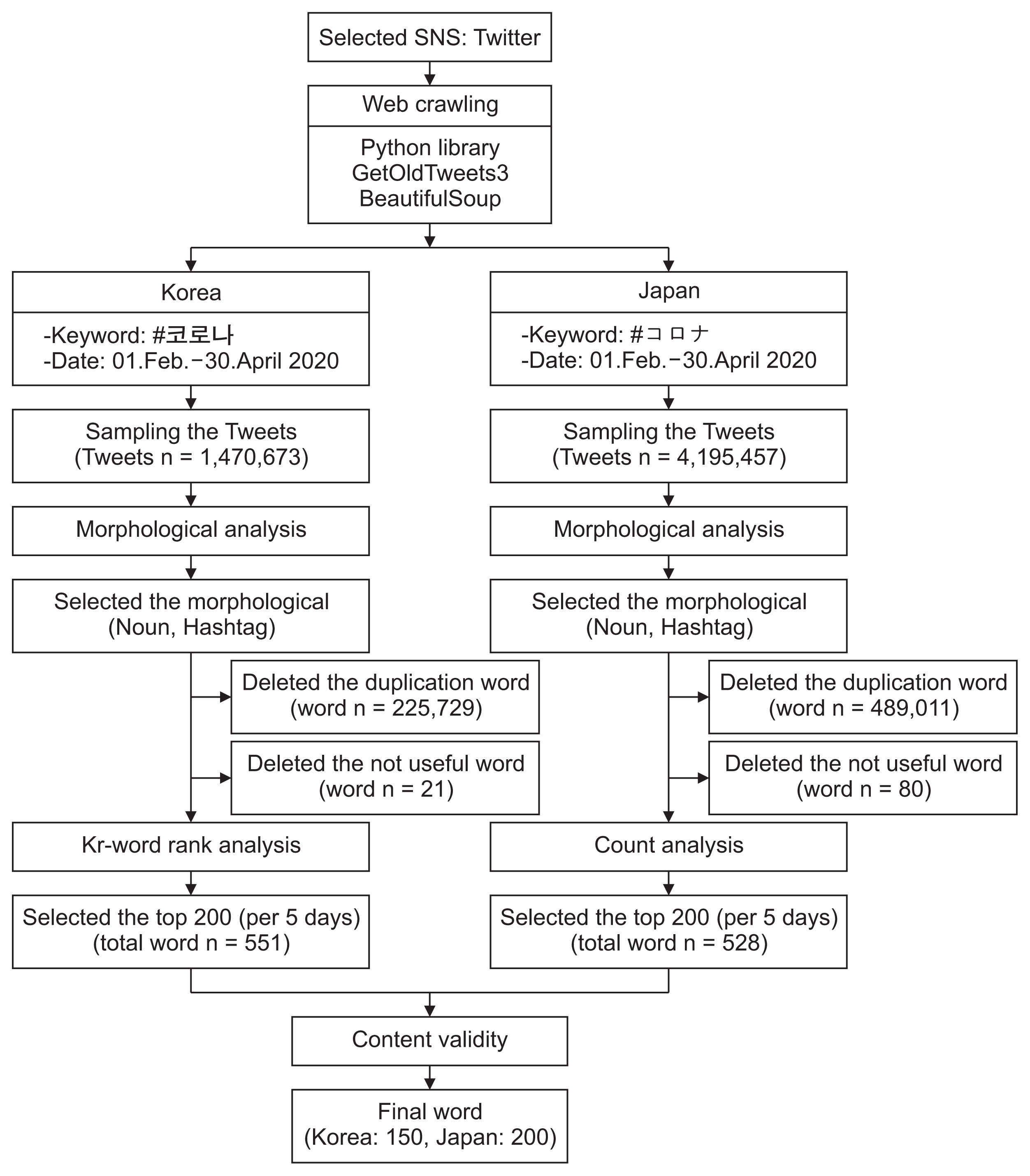
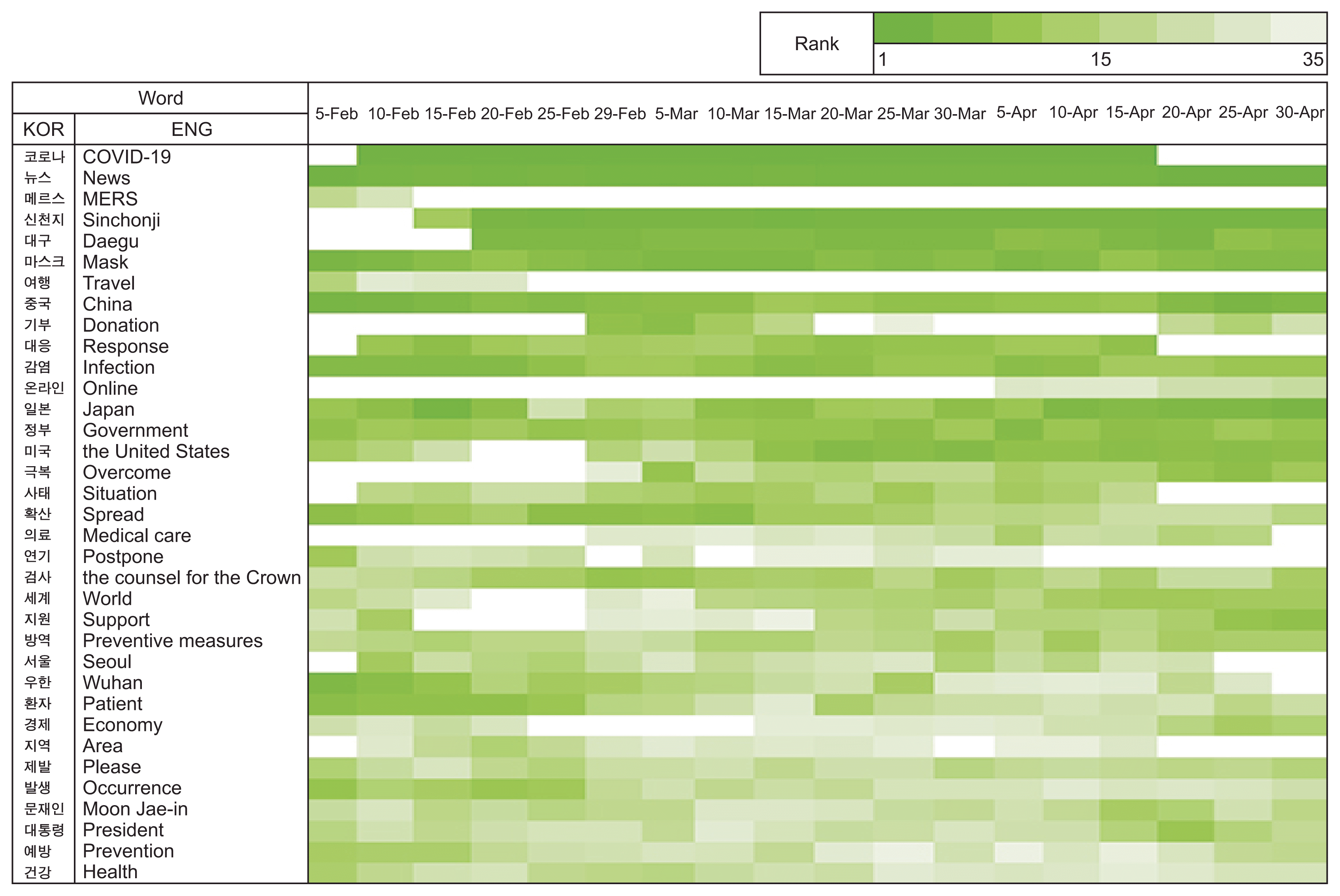
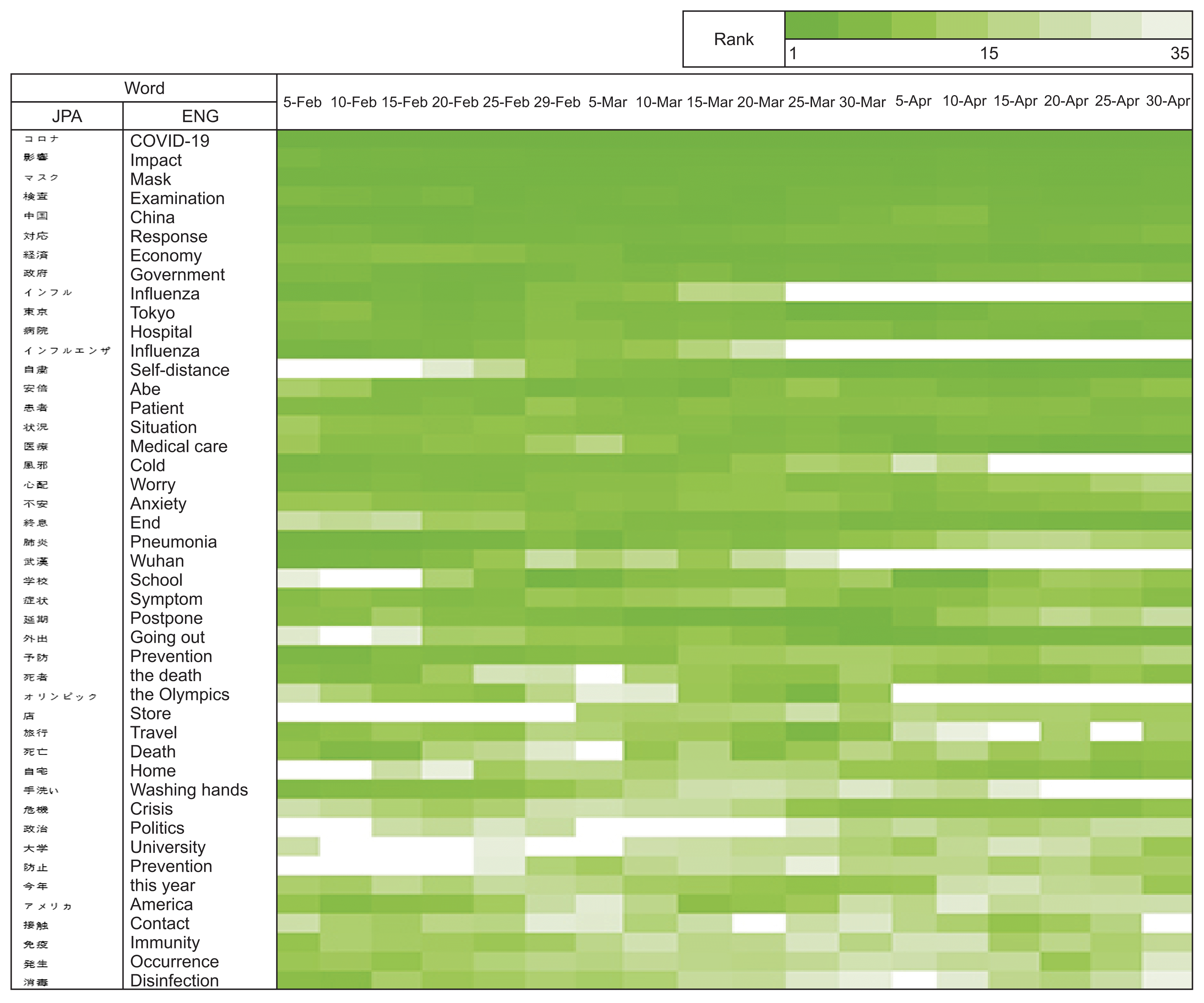
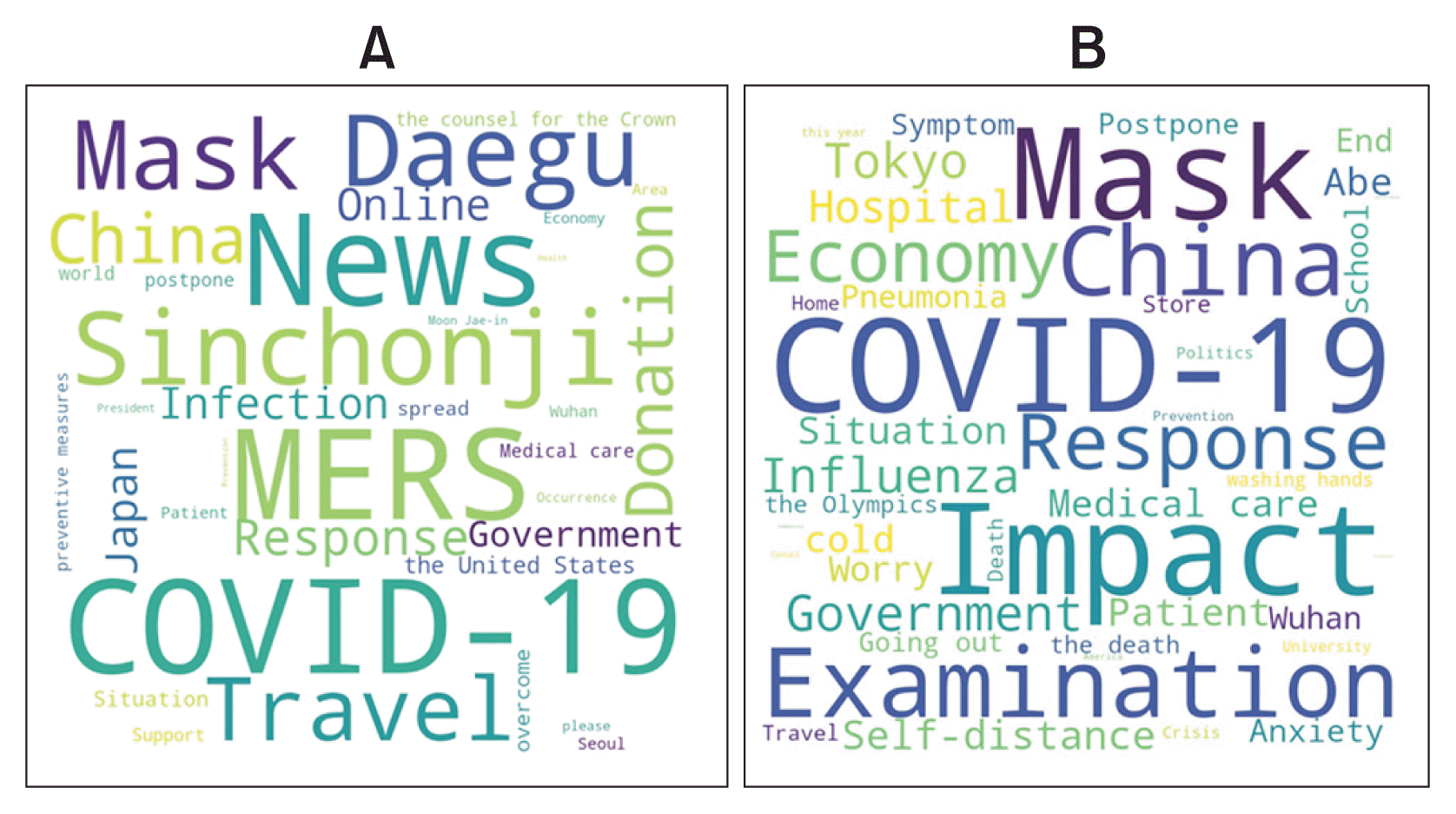
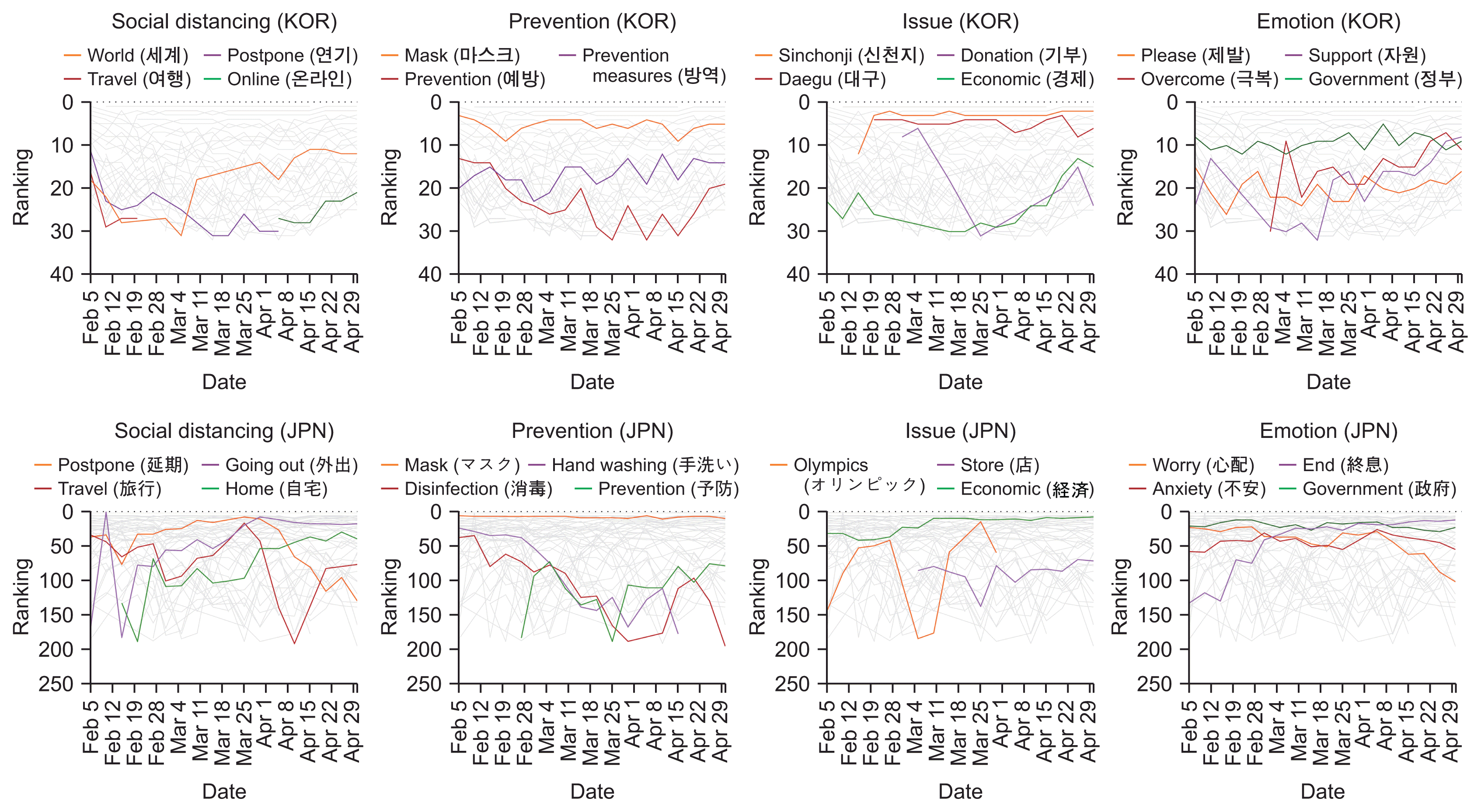
 XML Download
XML Download